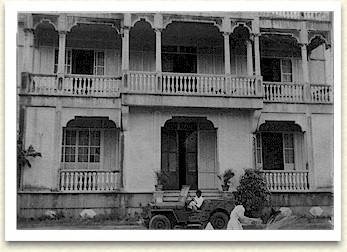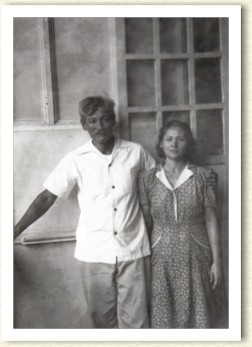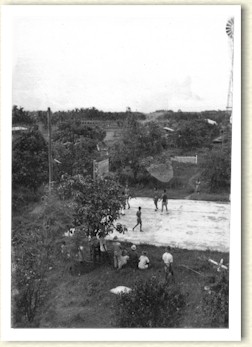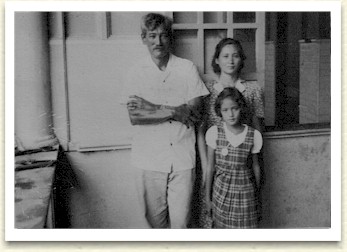|
The
Gaston Deliverance
 It
was during the March/June 1945 period that something to which only passing
attention was given at the time began to develop in a
direction that, 65 years later, became extraordinary. At
the time I was "F" Company's Executive Officer, and Bill Bailey was my
Company Commander. It
was during the March/June 1945 period that something to which only passing
attention was given at the time began to develop in a
direction that, 65 years later, became extraordinary. At
the time I was "F" Company's Executive Officer, and Bill Bailey was my
Company Commander.
Prior to our deployment to the area, in early March,
shortly after our return from Corregidor to Mindoro, Bill Bailey was one of
a number of 503d
officers taken on B-24 missions from Mindoro to inspect the area for
possible landing grounds
and to familiarize themselves with the terrain. From
the air it had been easy to see that the Japanese had been
burning the large haciendas in the area, and had torched some
nearby. The aircraft Bailey was in also had strafed a Japanese
truck that was spotted heading from the highway to a large
plantation house. The truck exploded.

A few days later, on 7 March, we had been flown to Iloilo City,
where we were disembarked and transferred across the Guimaras straits
to Negros. The following day we were trucked to the lower part
of what was to become known to us as the Tokaido Road, which
wound across the rolling countryside ever upwards towards the
island's mountainous interior. We didn't know it yet, but we had
been thrown in to support the 40th Division, in what was to
eventually become the worst misuse of US paratroops throughout
WWII.
Thus, not very long after, I found myself billeted at the Victorias
Elementary School and assigned to provide protection to the
area, and to its important personages not merely from those
still marauding Japanese who had not entirely moved from the
coastal areas to the mountainous interior, but also against
roving bands of armed Filipino brigands more interested in
plundering from the population than in fighting the Japanese.

At the time, Jose Gaston was the single most important person in
my area of responsibility, and I was soon to discover that
his Hacienda Santa Rosalia in Manalpa was the ancestral home of
the sons of Yves Leopold Germain Gaston. Yves Gaston, a
Frenchman, had settled in Negros Occidental and had been
instrumental in modernizing the sugar industry there. During the
Japanese occupation, the entire Gaston clan had moved there to
the relative safety that the province offered, the
Japanese on Negros having until lately been mostly tolerable. It
had also helped to spread the story that Jose had contracted
tuberculosis, for the Japanese had a great fear of it, and gave
it wide berth. Unfortunately, in Jose's case, it was true.
Thus
I found almost a hundred people living in the hacienda itself
and nearby in its immediate grounds. It wasn't just a big
house, it's role was almost that of a US County seat, or that of
a manor house to a feudal fiefdom. During the war
the growing of sugar in the region had almost largely ceased,
and it was now important to get the region to a point where it
could be restarted economically. Sugar exported from
Negros was more than 60% of the Philippines' output, and almost
all of which was exported to the US.
The hacienda had its own swimming pool and
a basketball court, which became a place where the men could
work up a sweat in a fast game. It also had
extensive gardens, large comfortable shaded verandahs, and
a huge table in the upstairs sala above, around which at
least two dozen men could dine in without difficulty.

During the day we patrolled Highway 1 in our five well
equipped jeeps, dealing with reports of Japanese foragers
who were still in the area, and picking up prisoners.
Sometimes we would take a break to the hospitality of the Gaston's
where we would sit at the hacienda's immense table and discuss the
business of the day over home-cooked meals prepared from the
supplies available in our rations, mixed with vegetables and
produce bought at the local market.
Jose
was clearly well educated, well-connected, well-travelled
and as astute a judge of human foibles and politics as I had met
in years. His wife, Consuelo was both charming and attractive wife, as befitted such a man
of his times, and they had gaggle of extremely charming (and
correspondingly well
chaperoned) daughters.

It
was around the table that I found that the Gaston family had
watched in fear as it had seen the Japanese torch the
neighboring haciendas, and how they saw their immediate fate as
the Japanese had driven towards their house. Some had knelt and
prayed for deliverance.
Extraordinarily,
that deliverance had come from the turret of a B-24.
Then, and
thereafter, the saving of the family, its hacienda
and the community that depended upon them from the
Japanese torch was ascribed to the intercession of Saint * as much as to the
intercession of Saint Bill Bailey in a B-24. Not to mind,
the incident had probably prevented a massacre of some of the
almost one hundred people who had spent their war living in and
around the hacienda, and of course the destruction of the
hacienda itself.
 In
2010, there was a reunion at the Gaston's Hacienda
Sta. Rosalia to
celebrate once again the deliverance of their family and world
from evil, at which the gaggle of extremely charming daughters,
now in their 70's and 80's, again presided.
Other than the vegetation, the hacienda is just like it was in
1945.
The toast was to Capt. Bailey, Capt. Calhoun, and the 503d PRCT,
and to those who did not return home. In
2010, there was a reunion at the Gaston's Hacienda
Sta. Rosalia to
celebrate once again the deliverance of their family and world
from evil, at which the gaggle of extremely charming daughters,
now in their 70's and 80's, again presided.
Other than the vegetation, the hacienda is just like it was in
1945.
The toast was to Capt. Bailey, Capt. Calhoun, and the 503d PRCT,
and to those who did not return home.
|